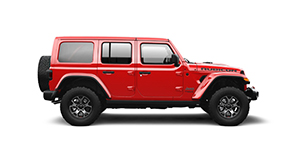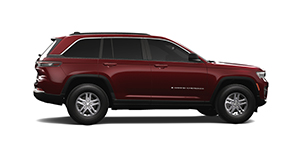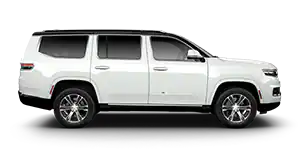1950-1959
The 1950s saw the rise of the recreation vehicle, as well as engineering superiority. Grass-roots enthusiasts helped launch Jeep® Jamborees and took the original freedom machine to new heights in sales thanks to seven unique models.
WELCOME WILLYS MOTORS
The word “Jeep” became a registered trademark of Willys-Overland in 1950. A short three years later, the company was sold to Henry J. Kaiser for $60.8 million and becomes Willys Motors Inc. The CJ model was updated in 1953, followed by the CJ-5 in 1955. The company was marketed as the “The world’s largest maker of four-wheel-drive vehicles.”
A TALE OF FREEDOM
M38 (MC)
M-38A1 (MD)
M-170 (MD-A)
JEEP® CJ-3B (UNIVERSAL)
JEEP® CJ-5
JEEP® CJ-6
JEEP® FC-150 (FC)
JEEP® FC-170 (FC)
JEEP® DJ-3A
1950-1952 JEEP® M38 (MC)
A NEW BATTLE-READY JEEP® BRAND 4x4
Essentially a combat-ready version of the CJ-3A, the M38, or Willys Model MC, was the first post-WW II military Jeep® Brand vehicle. The M38 included several key changes including: stronger frame and suspension. It could be driven completely submerged thanks in part to a new waterproofed 24-volt ignition system (replaced the CJ-3A’s 6-volt system), and a unique vent tube system that connected the fuel tank, transfer case, transmission, and engine to the air cleaner.
Jeep® M38. Courtesy of Hyman Ltd Classic Cars.
The 1950 Jeep® CJV-35/U, a derivation of the M38, was the first production Jeep 4x4 with factory-included deep water fording capability. The CJV-35/U was made primarily for the U.S. Marine Corps. (Not shown).
Jeep® M38. Courtesy of Hyman Ltd Classic Cars.
Later models would add black out lamps, headlight guards, and ability to carry tools on the side of the M38 similar to the original Willys MB. The M38 is known by many as, “the best of the flat fenders.”
Jeep® M38. Courtesy of Hyman Ltd Classic Cars.
The M38 served honorably in the Korean War, all along the 38th parallel, and was popularized as a “supporting actor” in nearly every episode of the popular TV series M*A*S*H.
Jeep® M38. Courtesy of Hyman Ltd Classic Cars.
1952-1971 JEEP® M-38A1 (MD)
AN AUTOMOTIVE MASTERPIECE
The M-38A1, also known as the MD, the design would later be the foundation for the classic CJ-5. The M-38A1 featured a two-piece windshield, longer wheelbase, softer ride, more powerful engine, and new, more rounded body. The “round-fender” Jeep® Brand vehicle would eventually become the foundation for the CJ-5. The M-38A1 was one of the most enduring military Jeep Brand vehicles. Some called it the last “true” military Jeep vehicle.
Jeep® M-38A1 ¼-ton vehicle.
In 1951, Museum of Modern Art declared the Jeep® Brand 4x4 as a cultural icon and saluted it as one of the world’s eight automotive masterpieces. In 2002, a 1952 Willys M-38A1 was added it to its permanent collection of significant vehicles, describing it as “the best Jeep ever built.”
Jeep® M-38A1 ¼-ton vehicle.
The M-38A1C (not shown), a specially modified Army Jeep® Brand 4x4 produced through 1971, was designed to transport 106mm and 105mm recoilless rifles. A unique channel opening in the windshield allowed the barrel of the rifle to rest on the front hood. What was the most “powerful” Jeep vehicle ever built? Some would say the M-38A1D—it was equipped with a Davy Crocket missile launcher that could fire tactical nuclear weapons. The user could launch the 279mm 1-Kiloton-yield atomic projectile to a range of 2,000 meters from its 120mm recoilless gun.
Jeep® M-39A1.
The 1951 Jeep® CJ-4M, also known as the M-38E1, was a transitional vehicle, a variant of the CJ-3A with a taller cowl and rounded hood. The new features cleared space to fit the new F4-134 “Hurricane” engine under the hood. However, despite the apparent quality of the build, it only existed as prototype. The historical purpose of the CJ-4M, then, became to link the CJ-3A to the next military-specific model, the new Jeep® Willys MD.
1951 Jeep® CJ-4M prototype vehicle.
1953-1964 JEEP® M-170 (MD-A)
LIGHT TROOP CARRIER/AMBULANCE
The Jeep® M-170 could be fitted with several different body packages. One was a light troop carrier. Because the wounded could be carried inside, the M-170 was also heavily used as a field ambulance.
Jeep® M-170 Ambulance.
The CJ-4MA-01 (earlier known as Model MC-A) featured skirted flat fenders, a large passenger door and lengthened tub. This vehicle bridges the gap between the M-38 and the round fender M-38A1.
1951 Willys-Overland Experimental Project 6396 for CJ-4MA-01 for Jeep® Ambulance dated 3-23-51.
A long-wheelbase four-wheel drive prototype ambulance was released to the U.S. Army in 1951 for testing (project 6396). The ambulance was a slightly elongated 1951 Jeep® CJ-4M, another prototype in the history of the Jeep Brand.
1951 Willys-Overland Experimental Project 6396 for MC-A (with side-curtains rolled up) for Jeep® Ambulance dated 1-21-51.
A long-wheelbase (101-inch) M-170 featured a body that was lengthened 20 inches over the standard Jeep® M-38A1. It was fitted with a heavier suspension and a spare tire and included a jerry can mounted in the body tub next to the passenger seat. It was also known as the MD-A.
Jeep® FC-170 military vehicle.
1953-1968 JEEP® CJ-3B (UNIVERSAL)
A MORE POWERFUL JEEP® CJ
Willys dramatically updated its CJ line on January 28, 1953 with the CJ-3B—the first CJ with a dramatically different style from its military ancestor, the Willys MB. The CJ-3B featured a higher hood to accommodate a taller “Hurricane” “F-head” engine. If ever there was a complaint with the CJ-2A and CJ-3A it was with the lack of power. The new engine put that complaint at rest. The “F-head” style overhead-valve engine, designed by Barney Roos, produced a remarkable 25% more horsepower and 9% more torque.
Jeep® CJ-3B.
The CJ-3B remained in production for fifteen years. By 1968, over 155,000 are sold. Also, a one-off CJ-4 was produced in 1951, a hybridization of the M38-series and soon-to-come CJ-5.
Jeep® CJ-3B.
From 1949 to 1964, either a complete Jeep® Brand vehicle or chassis was used on all Zamboni® ice resurfacing machines. In 1949, the Model A took 10 minutes to do a job that used to take over 90 minutes.
Zamboni® Model #12 Ice Resurfacing Machine that used a Willys CJ-3B body. Photos: © Zamboni Company Archives.
The fresh powerplant was mated to a new transfer case that was designed to offer longer life and quieter operation.
Early Jeep® CJ-3B advertisement.
1955-1983 JEEP® CJ-5
A CIVILIAN JEEP® BRAND VEHICLE FOR THE MASSES
In October 11, 1954, Kaiser announced the arrival of the CJ-5, and featured softer styling lines, including rounded body contours based on the 1952 Korean War M-38A1. The CJ-5 was better on every front: it was stronger, more comfortable, more versatile, and more off-road capable. It was slightly larger than the CJ-3B, as it featured an increased wheelbase and overall length. Improvements in engines, axles, transmissions and seating comfort made the 81-inch-wheelbase CJ-5 an ideal vehicle for the public's growing interest in off-road vehicles.
Jeep® CJ-5.
Big news in 1965 was getting a new “Dauntless” V6 engine that produced 155 horsepower and 225 pound-feet of torque. The V6 engine nearly doubled the power of the standard four-cylinder engine. Beginning in 1973, all Jeep® CJ models were offered with available AMC-built 304- or 360-cubic-inch V8 engines. Spanning thirty years, the CJ-5 had the longest production run of any Jeep Brand vehicle, and in the sixteen years of Kaiser ownership, Jeep Brand vehicle manufacturing plants were established in thirty foreign countries, with Jeep Brand vehicles marketed in more than 150 countries worldwide.
1965 Jeep CJ-5.
Many special editions were offered, including the 1964-1967 “luxury” Tuxedo Park, the 1969 Camper, the 1969 “462”, the 1970 Renegade I, the 1971 Renegade II, the 1972-1983 Golden Eagle, and 1973 and 1976 Super Jeep®. The CJ-5 was a popular vehicle in fire departments and was outfitted to help put out brush fires. A two-wheel driver version DJ-5 was offered through 1974. A popular and enduring legend, the CJ-5 has probably logged more trail miles than any other Jeep Brand vehicle.
1960 Jeep® CJ-5 Fire Truck.
1955-1981 JEEP® CJ-6
A CIVILIAN JEEP® BRAND VEHICLE FOR THE MASSES
A common complaint of early CJ owners was the need for more room for passengers and gear. Willys Motors responded with the CJ-6. Basically a CJ-5 with a 20-inch-longer wheelbase (101 inches), the CJ-6 combined greater storage capacity and improved comfort. A chrome-trimmed Tuxedo Park model was offered in 1964 through ’67. A 192ci Perkins I-4 diesel engine was an available option (as it was on the CJ-5) from 1961 to ’69. AMC would later equip both the CJ-5 and CJ-6 with heavier axles, bigger brakes and a wider track. CJ-6s are prized by collectors. The commercial two-wheel drive version was called DJ-6. The export version remained in production until 1981. Jeep also introduced a forward-control cab-over-engine variation to the CJ line in 1957.
1964 Jeep® CJ-6 Tuxedo Park Mark 4.
AMC equipped the CJ-6 with heavier axles, bigger brakes and a wider track. In 1965, a new “Dauntless” V6 engine was introduced as an option on CJ-5 and CJ-6 vehicles. The 155-horsepower V6 almost doubled the horsepower of the standard four-cylinder engine. Beginning in 1973, all Jeep® CJs came equipped with AMC-built 304- or 360-cubic-inch V-8 engines.
1970 Jeep® CJ6 left front
1957-1965 JEEP® FC-150 (FC)
CAB-FORWARD DESIGN
In a bold departure from previous designs, Willys Motors unveiled its highly-maneuverable Forward-Control (FC) series of Jeep® four-wheel drive trucks. These highly maneuverable workhorses featured a unique cab-over-engine design gave them a hoodless, flat-nose appearance. While its "cab forward" styling had little in common with traditional Jeep vehicle body design, the FC-150 was actually built on top of the existing CJ-5 chassis.
"More cargo space! On less wheelbase! And goes 'anyplace'!" chirped FC ads of the time. And indeed, with the FC-150/170, workers and farmers had a vehicle that could go virtually anywhere (due to its eighteen-foot turning radius) while also hauling a load.
The FCs were remarkably convenient trucks—their unusually low beds making them easy to load and unload—that enjoyed popularity in foreign markets.
1956 Jeep® FC-150 pick-up truck.
Essentially work trucks – the cab-over-engine Jeep vehicles came in two models: an 81-inch wheelbase FC-150 with a four-cylinder F-head engine, and the 103.5 inch wheelbase for the FC-170 with a six-cylinder L-head engine.
Both models included pickup, stake bed, chassis & cab, and assorted special editions including the clever FC-150 railway track inspection vehicle.
1956 Jeep® FC-150 pick-up truck.
1957-1965 JEEP® FC-170 (FC)
In a bold departure from previous designs, Willys Motors unveiled its highly maneuverable Forward-Control (FC) series of Jeep® four-wheel drive trucks. These highly maneuverable workhorses featured a unique cab-over-engine design gave them a hoodless, flat-nose appearance. While its "cab forward" styling had little in common with traditional Jeep vehicle body design, the FC-170 was actually built on top of the existing CJ-5 chassis. It featured a 103.5 inch wheelbase and was equipped with a six-cylinder L-head engine. FC-170 models included pickup, stake bed, chassis & cab, and assorted specialty editions as well as an available heavy-duty dual-rear-wheel version.
1964 Jeep® FC-170 diesel military vehicle.
Both models included pickup, stake bed, chassis & cab, and assorted specialty editions, with the FC-170 also available in a heavy-duty dual-rear-wheel version. They were virtually unchanged throughout their production runs, save 1959 when the FC-170 received HD rear springs, which increased GVW to a max. 8,000 pounds: additionally, a few ’67 170s were offered with dual rear wheels and a four-speed manual transmission option that bumped GVW up to 9,000 pounds; some ’59-’60 FCs came with full-floating front and rear axles as well.
1964 Jeep® FC-170 diesel military vehicle.
In mid-1943 Willys-Overland worked with the U.S. Army to develop a lightweight 4x4 vehicle that could be dropped from an airplane into combat situations. Willys-Overland proposed the WAC (Willys Air Cooled) that was powered by a 24 hp Harley Davidson 49cc opposed twin-cylinder motorcycle engine mounted in the center of the vehicle. The WAC featured constant drive to all wheels and could disengage the front axle when needed. The forward-control design was later put into practical use in the cab-forward Jeep® FC-150 and FC-170 4x4 vehicles.
1943 Jeep® WAC 4x4 military vehicle.
JEEP® DJ-3A
DISPATCHER AT YOUR SERVICE
An eye-catching variation of the DJ-3A was the '59-64 "Surrey Gala" primarily intended for vacation resorts. Perhaps the gaudiest Jeep® Brand vehicle ever, it was available in three color schemes, Tropical Rose and Coral Mist, Jade Tint Green and Glacier White, and Cerulean Blue and Glacier White with a matching striped interior and striped top with fringe.
1959 Jeep® Surrey Gala.
The DJ-3A was advertised as “Perfect for economical deliveries” and “For carefree business and pleasure transportation.”
Jeep® DJ-3A utility truck








